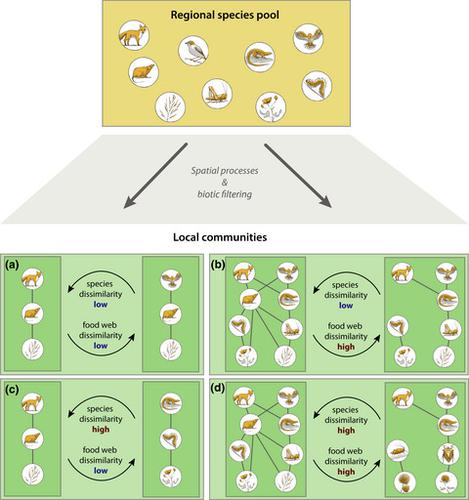当前位置:
X-MOL 学术
›
Ecol. Lett.
›
论文详情
Our official English website, www.x-mol.net, welcomes your feedback! (Note: you will need to create a separate account there.)
Biotic filtering by species’ interactions constrains food-web variability across spatial and abiotic gradients
Ecology Letters ( IF 8.8 ) Pub Date : 2022-03-14 , DOI: 10.1111/ele.13995 Barbara Bauer 1, 2, 3 , Emilio Berti 1, 2 , Remo Ryser 1, 2 , Benoit Gauzens 1, 2 , Myriam R Hirt 1, 2 , Benjamin Rosenbaum 1, 2 , Christoph Digel 4 , David Ott 5, 6 , Stefan Scheu 7, 8 , Ulrich Brose 1, 2
Ecology Letters ( IF 8.8 ) Pub Date : 2022-03-14 , DOI: 10.1111/ele.13995 Barbara Bauer 1, 2, 3 , Emilio Berti 1, 2 , Remo Ryser 1, 2 , Benoit Gauzens 1, 2 , Myriam R Hirt 1, 2 , Benjamin Rosenbaum 1, 2 , Christoph Digel 4 , David Ott 5, 6 , Stefan Scheu 7, 8 , Ulrich Brose 1, 2
Affiliation

|
Despite intensive research on species dissimilarity patterns across communities (i.e. β-diversity), we still know little about their implications for variation in food-web structures. Our analyses of 50 lake and 48 forest soil communities show that, while species dissimilarity depends on environmental and spatial gradients, these effects are only weakly propagated to the networks. Moreover, our results show that species and food-web dissimilarities are consistently correlated, but that much of the variation in food-web structure across spatial, environmental, and species gradients remains unexplained. Novel food-web assembly models demonstrate the importance of biotic filtering during community assembly by (1) the availability of resources and (2) limiting similarity in species’ interactions to avoid strong niche overlap and thus competitive exclusion. This reveals a strong signature of biotic filtering processes during local community assembly, which constrains the variability in structural food-web patterns across local communities despite substantial turnover in species composition.
中文翻译:

物种相互作用的生物过滤限制了食物网在空间和非生物梯度上的变异性
尽管对跨群落的物种差异模式(即β多样性)进行了深入研究,但我们仍然对它们对食物网结构变化的影响知之甚少。我们对 50 个湖泊和 48 个森林土壤群落的分析表明,虽然物种差异取决于环境和空间梯度,但这些影响仅微弱地传播到网络。此外,我们的研究结果表明,物种和食物网的差异始终是相关的,但食物网结构在空间、环境和物种梯度上的大部分变化仍然无法解释。新的食物网组装模型通过(1)资源的可用性和(2)限制物种相互作用的相似性以避免强烈的生态位重叠和竞争排斥,证明了生物过滤在群落组装过程中的重要性。这揭示了当地社区组装过程中生物过滤过程的强烈特征,这限制了当地社区结构食物网模式的可变性,尽管物种组成发生了大量更新。
更新日期:2022-03-14
中文翻译:

物种相互作用的生物过滤限制了食物网在空间和非生物梯度上的变异性
尽管对跨群落的物种差异模式(即β多样性)进行了深入研究,但我们仍然对它们对食物网结构变化的影响知之甚少。我们对 50 个湖泊和 48 个森林土壤群落的分析表明,虽然物种差异取决于环境和空间梯度,但这些影响仅微弱地传播到网络。此外,我们的研究结果表明,物种和食物网的差异始终是相关的,但食物网结构在空间、环境和物种梯度上的大部分变化仍然无法解释。新的食物网组装模型通过(1)资源的可用性和(2)限制物种相互作用的相似性以避免强烈的生态位重叠和竞争排斥,证明了生物过滤在群落组装过程中的重要性。这揭示了当地社区组装过程中生物过滤过程的强烈特征,这限制了当地社区结构食物网模式的可变性,尽管物种组成发生了大量更新。

























 京公网安备 11010802027423号
京公网安备 11010802027423号